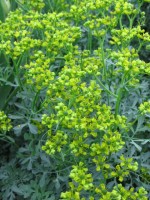 Also called herb of grace, rue is an evergreen mounding subshrub and a member of the Rutaceae family that also includes oranges, limes, and skimmia. It is native to the Balkan Peninsula where it grows on dry hillsides, often on limestone. Growing up to 3’ tall, the plant has a woody base and blue-green pinnately compound leaves 3-5” long with oblong to spatulate leaftlets. The leaflets are fleshy, dotted with glands, and are very aromatic when crushed. The dull yellow flowers have 4-5 petals, are ¾” across, and appear in flattened corymbs in early summer. Plants are usually grown for the attractive foliage and are popular in herb and rose gardens. Plants like full sun, average to lean, dry to medium moist, well-drained soil in USDA Hardiness Zones 4-9. Reproduction is by seed and terminal cuttings in late summer and early fall. The genus name, Ruta, is probably related to the Greek word reuo meaning set free and refers to the medicinal qualities of the herb. The specific epithet, graveolens, may be related to the Latin word gravis meaning heavy, and refers to the scent.
Also called herb of grace, rue is an evergreen mounding subshrub and a member of the Rutaceae family that also includes oranges, limes, and skimmia. It is native to the Balkan Peninsula where it grows on dry hillsides, often on limestone. Growing up to 3’ tall, the plant has a woody base and blue-green pinnately compound leaves 3-5” long with oblong to spatulate leaftlets. The leaflets are fleshy, dotted with glands, and are very aromatic when crushed. The dull yellow flowers have 4-5 petals, are ¾” across, and appear in flattened corymbs in early summer. Plants are usually grown for the attractive foliage and are popular in herb and rose gardens. Plants like full sun, average to lean, dry to medium moist, well-drained soil in USDA Hardiness Zones 4-9. Reproduction is by seed and terminal cuttings in late summer and early fall. The genus name, Ruta, is probably related to the Greek word reuo meaning set free and refers to the medicinal qualities of the herb. The specific epithet, graveolens, may be related to the Latin word gravis meaning heavy, and refers to the scent.
Since ancient times rue has been used as a medicinal herb to improve eyesight, induce abortion, and to treat a variety of conditions from indigestion to epilepsy. In the Middle Ages, rue was used against witches and their spells, to ward off the plague and to sprinkle holy water before a Catholic high mass. In the 16th -17th centuries rue was used in courtrooms to guard against jail fever. In spite of its colorful historical history as a medicinal herb, the problems associated with its use have led to its cultivation in modern times primarily as an ornamental instead. The leaves are toxic if ingested and can photosensitize the skin causing very painful watery blisters on sensitive individuals.